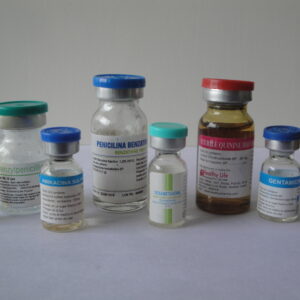Description
Amikacin veterinary injection
Amikacin is commonly used in veterinary medicine to treat bacterial infections in animals. The medication is particularly effective against Gram-negative bacteria. The 250 mg dosage you mentioned is likely the strength of the amikacin per unit volume in the injection.
The specific usage and dosage of amikacin for veterinary purposes depend on various factors, including the type of animal, the nature and severity of the infection, the animal’s weight, and the veterinarian’s assessment. Here are some general guidelines:
Bacterial Infections: Amikacin is often prescribed to treat bacterial infections, especially those caused by susceptible Gram-negative bacteria. It can be used for conditions such as respiratory, urinary tract, skin, and soft tissue infections.
Dosage: The dosage will be determined by the veterinarian based on the specific circumstances of the animal being treated. It is crucial to follow the veterinarian’s prescription carefully, and the dosage may be given as a one-time injection or divided into multiple doses depending on the severity of the infection.
Administration: Amikacin is typically administered through intramuscular (IM) or intravenous (IV) injection. The choice of administration route depends on the veterinarian’s recommendation and the nature of the infection.
Monitoring: Regular monitoring of the animal’s response to treatment and any potential side effects is essential. If there are any adverse reactions or if the condition does not improve, it’s important to inform the veterinarian promptly.
Precautions: Aminoglycoside antibiotics, including amikacin, can have potential side effects such as kidney and hearing damage, especially with prolonged use. Veterinarians will weigh the benefits of treatment against the potential risks and monitor the animal closely during the course of therapy.
It’s crucial to consult with a veterinarian before administering any medication, and the use of amikacin or any other antibiotic should be done under their guidance to ensure the safety and well-being of the animal.
Amikacin is an antibiotic commonly used in veterinary medicine to treat bacterial infections in animals. The 250 mg strength you mentioned typically refers to the dosage of amikacin in the form of an injectable solution. It’s important to note that the specific usage, dosage, and administration route should be determined by a veterinarian based on the individual animal’s condition.
Here are some general guidelines for the usage of Amikacin in veterinary medicine:
Bacterial Infections: Amikacin is effective against a range of Gram-negative bacteria. It may be prescribed for various infections, such as respiratory, urinary tract, skin, and soft tissue infections.
Dosage: The dosage of Amikacin can vary based on the animal’s weight, the severity of the infection, and the specific type of bacteria involved. Veterinarians will calculate the appropriate dosage for the animal being treated.
Administration: Amikacin is typically administered by injection. The veterinarian will determine the route of administration (intramuscular or intravenous) based on the specific needs of the case.
Frequency: The frequency of administration will depend on the veterinarian’s prescription. It may be given once daily or divided into multiple doses throughout the day.
Monitoring: Veterinarians may monitor the animal’s response to treatment and adjust the dosage or treatment plan if necessary. They may also conduct tests to ensure that the antibiotic is effectively targeting the specific bacteria causing the infection.
It’s crucial to follow the veterinarian’s instructions precisely, complete the entire course of treatment, and not discontinue the medication without consulting the veterinarian, even if the animal’s symptoms improve.
As always, the information provided here is general, and specific details should be discussed with a licensed veterinarian who can evaluate the individual case and provide tailored guidance. Self-administration of veterinary medications without proper guidance is not recommended and can be harmful to the animal’s health.
Amikacin is commonly used in veterinary medicine to treat bacterial infections in animals. It belongs to the aminoglycoside class of antibiotics and is effective against a range of Gram-negative bacteria. Here are some common usages of Amikacin 250 mg for veterinary injection:
Bacterial Infections: Amikacin is often prescribed to treat bacterial infections in various animals, including dogs, cats, horses, cattle, and other livestock. It is effective against bacteria such as Escherichia coli, Pseudomonas aeruginosa, Klebsiella, and others.



